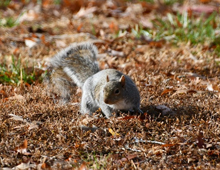
Fox Squirrel removal and control can be realy hard and should only be attempted by a professional animal removal agent!
Eastern and Western Fox squirrels are found throughout the United States, south into northern Mexico, and north into Canada.
Just as people have different colored hair, fox squirrels have different fur color patterns: in most areas the animals are brown-grey to brown-yellow, while in eastern regions such as the Appalachians there are more strikingly-patterned dark brown and black squirrels with white bands on the face and tail. In the south, one will see isolated communities with uniform black coats.
Fox squirrels, like other types of squirrels, help support the ecosystem by being prey for owls, eagles, and snakes. Through their legendary caching (food-burying) behavior, they support forests by spreading and burying seeds. Fox squirrels are diurnal, active during the day.
They’ll nest almost anywhere where there are trees, from forested areas to riparian (stream- or river-side) areas to suburban and urban areas. They construct two types of dreys (nests), depending on the season. Summer dreys are often little more than platforms of sticks high in the branches of trees, while winter dreys are usually hollowed out of tree trunks by a succession of occupants over as many as thirty years. They prefer more open habitats than the eastern grey squirrel, and will frequently been seen in prairie areas that greys avoid.
Fox Squirrel Nuisance Factors
One reason why fox squirrels have been able to adapt to so many different habitats is their flexible diet. They’ll eat leaves, seeds, grains, nuts, and fruit; insects; bird eggs, small non-insect arthropods, and carrion. This, along with their impressive climbing and leaping abilities, has made them pests to farmers and residential gardeners.
Fox squirrels carry certain diseases such as tularemia and ringworm that are transmissible to people. They are frequently infested with fleas, mites, and other ectoparasites.
Fox squirrels, like other tree squirrels, will often build satellite squirrel nests in the walls, chimneys, and under the roofs of houses, sheds, and garages. They are also know to build nest in attics
In urban and suburban areas, tree squirrels are difficult to control because of their great mobility and because many people feed and provide nest boxes for the squirrels in order to encourage their presence. It is relatively easy to keep squirrels out of buildings, but keeping them out of a yard or garden is a continuous challenge.
Dealing with Fox Squirrels
Although some chemical repellents are registered for use to keep tree squirrels out of an area, their effectiveness is questionable. There are also repellents that are added to birdseed that are supposed to prevent squirrels from feeding on the seeds; however these have shown little promise.
Fox squirrels quickly become habituated to visual or sound frightening devices and pay little attention to them after a couple of days. A number of these devices are on the market, but none have proven very effective.
Tree squirrels are quick to escape when pursued by predators. Dogs that have full run of the yard might keep squirrels at bay. Predators in urban and suburban areas generally have little effect on tree squirrel populations.
Trees that overhang roofs or are close to telephone lines should be cut back to slow the movement of squirrels about the yard.
Screening or blocking all potential entrance sites such as small gaps under the eaves, overlapping roof sections, and knotholes, can prevent tree squirrel access to buildings. Because they often travel on overhead telephone lines, power lines, and fence tops, they frequently find entrances at about these heights. When even a small opening is found, they can enlarge it by gnawing. In the absence of an obvious entrance, they can gnaw and create an entrance into an attic. Sheet metal or 1/4-inch wire hardware cloth are suitable materials for closing entrances. When closing entry routes, be sure you haven’t screened an animal inside the building. One way to test whether any squirrels are left is to plug the entrance with a loose wad of newspaper; if any remain inside they will remove the plug to get out.
It is virtually impossible to keep squirrels out of fruit or nut trees because of their superb climbing and jumping ability. Sometimes if there are other unprotected fruit or nut trees available to the squirrels, you can protect the crop of a single tree by netting it. While squirrels can readily gnaw through the plastic netting, they may not persist if sufficient alternative food is easily available.
Squirrels can be discouraged from digging up newly seeded or established crops by covering the rows with cagelike freestanding covers made of one-inch hexagon chicken wire.
Numerous devices and methods are commercially available from specialty catalogs for physically excluding tree squirrels from feeders; some of these work better than others. Tree squirrels are amazingly clever and agile so just about any feeder is susceptible.
Other exclusion tactics:
§ Wrap tree trunks with 12" (or greater) aluminum flashing at least 6 feet off ground.
§ Screen attic vents from the outside with 1/4" hardware cloth to prevent entry.
§ Cap all chimney flues with professionally manufactured stainless steel caps.
Trapping and Baiting Fox Squirrels
If you are tempted to trap or leave out poisoned baits for squirrels, it is best to check with a licensed pest removal company. They will be up-to-date on all local laws concerning the animals; some squirrels are protected in some areas and either cannot be trapped or require a permit for their removal. Squirrels can also carry diseases and parasites that are transmissible to humans. Furthermore, professional pest control companies will be familiar with the most effective trapping techniques and approaches.
